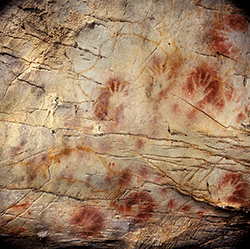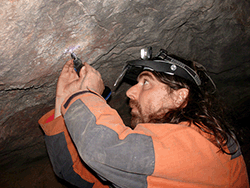
(Courtesy Pedro Saura)
Up until now, it has been believed that only Homo sapiens could have created Paleolithic cave art. Neanderthals, modern humans' closest extinct kin, who died out 30,000 years ago, were thought to be incapable of such activities. But new work coming from sophisticated dating techniques suggests otherwise: Neanderthals may have been artists.
In mid-June 2012, a team of European researchers announced the results of a reinvestigation of 50 paintings found in 11 caves on the northwestern coast of Spain. Notably, rather than directly examining the art, scientists instead analyzed calcium carbonate (calcite) crusts that covered the paintings. They used a technique called uranium-thorium dating. The calcite covering, which is formed by the same process as stalagmites and stalactites, contains trace amounts of uranium, which decays over time into thorium. Using mass spectrometry, scientists can measure thorium in a calcite sample as small as a grain of rice to arrive at an approximate date when the crust formed. That date is the minimum possible age of the art behind it.
One of the paintings tested was of a red disk that archaeologists say was probably made by blowing pigment onto the wall in a cave known as El Castillo. Archaeologists previously estimated the disk, which is surrounded by hands stenciled in red, to be 38,000 years old. The new analysis dates the disk to at least 40,800 years old, making it the oldest example of European cave art—4,000 years older than paintings at Chauvet Cave in southern France.
Thus, the disk's creation took place around the time when modern humans first arrived in Europe, sometime between 40,000 and 45,000 years ago. João Zilhão, a Paleolithic archaeologist at the University of Barcelona who coauthored a paper in Science on the new analysis, believes the earliest evidence of modern humans in Europe is a 41,500-year-old mandible found in the Romanian cave Peştera cu Oase. But says Zilhão, "We don't know if European cave art arrived with the first modern humans." He and his team think the revised date of the El Castillodisk suggests Neanderthals could be responsible for the painting.

(Courtesy Pedro Saura)
Evidence is now amassing that the gap between Neanderthal and human abilities was not as wide as has been believed. If it can be proved that these are their paintings, Neanderthals would have been capable of symbolic thought, since painting involves using images to convey meanings understood within a social group. Erik Trinkaus, a professor of physical anthropology at Washington University in St. Louis and a frequent collaborator of Zilhão's, says his colleague's assertion is not unreasonable. He points to the 2002 discovery of a Neanderthal artist's palette of ochre in a Romanian cave and Zilhão's own work at a Neanderthal site in Spain that uncovered pigmentstained mollusk shells that might have been worn as jewelry. "We now have a series of examples of different kinds of pigment use in archaeological contexts that can only be associated with Neanderthals," Trinkaus says.
Zilhão's team plans to continue sampling hand stencils and geometric symbols (often the oldest works found in caves) throughout Europe looking for paintings older than 42,000 years. If they find any, Zilhão says, "The results could be described as the last nail in the coffin of the 'Neanderthals as a different and cognitively handicapped species' concept."
Eric Delson, a professor of anthropology at Lehman College of the City University of New York, says a date on a painting won't be enough. In order to prove Neanderthals were cave artists, he believes archaeologists will need to find bones or tools in a cave layer that corresponds directly to the art on a wall.
Zilhão disagrees. "You don't have to have both the art and the occupation in the same site," he says, noting that there are no associated human remains at caves famous for their Paleolithic art, such as Chauvet. "These are just places where people went to make this stuff."

